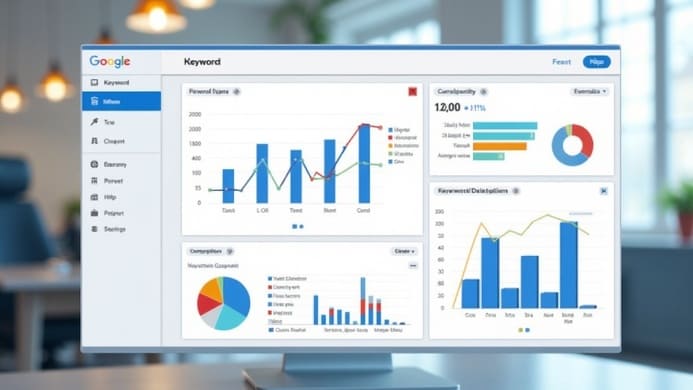Keyword Competition Analyzer For SEO Success

Finding Keywords To Target Using A Keyword Competition Analyzer
Finding the right keywords to focus on is a really important part of SEO. Keyword competition analyzers make this much easier, taking out a lot of guesswork and saving valuable time.
I rely on these tools to spot which keywords are worth targeting and how tough it might be to rank for them.
This article covers how a keyword competition analyzer work, how to use them effectively, and why they can take your content strategy up a notch.
Understanding Keyword Competition Analyzers
Keyword competition analyzers are tools that check how difficult it would be to rank for certain keywords in search engines like Google.
These tools can show you how many other sites are using the same keyword, the quality and authority of those sites, and how much search demand the keyword has.
With my experience in SEO research, I’ve found these analyzers really useful for guiding decisions and avoiding wasted effort on targets that are either too competitive or too obscure.
Tools like Ahrefs, SEMrush, and Moz are popular examples. They crunch large amounts of data and provide easy-to-read scores or scales showing how competitive a keyword is.
Most keyword tools also make suggestions for alternative or related keywords, which can help you track down new opportunities.
How to Analyze Keywords Effectively
When I sit down to analyze keywords, I always start with a clear goal in mind.
Whether I’m creating new blog posts, planning a product launch, or reviewing existing content, I want the keywords to match what my target readers are actually searching for.
This is where the keyword competition analyzer comes into play. Here is how to use the tool properly:
- Start with Seed Keywords: I usually type in broad seed keywords related to my topic. The keyword competition analyzer tool then suggests related phrases, giving me ideas for content I hadn’t considered.
- Check Search Volume and Trends: Higher search volumes mean more people are looking for that topic, but if competition is too high, it might be tough to rank. I look for steady or growing search trends as a positive sign.
- Review Competition Scores: Tools assign a number or label to show how tough a keyword is to rank for. Lower scores mean less competition. I balance this with the search volume to find the sweet spot.
- Analyze the Top Results: I always check the top-ranking pages. If most results are high authority brands with lots of backlinks, I know it will take more work to compete.
- Consider Keyword Intent: Understanding why someone searches a keyword—are they looking to buy, learn, or find a specific site—helps me choose the best match for my content goal.
By following these steps, I can focus my content efforts where there’s a realistic shot of ranking well.
Stumbling Upon Target Keyword Opportunities
Keyword competition analyzers help me track down areas where I have the best chances to succeed. Here’s what I do to track down new keyword opportunities:
- Look for Low Competition, High Volume Keywords: These keywords can bring in a lot of traffic without fighting against well known websites.
- Explore Longtail Variations: Phrases that are longer and more specific usually have lower competition. For example, instead of just “running shoes,” I might look at “best lightweight running shoes for flat feet”.
- Spot Rising Trends: Some tools offer trend data, showing if a topic is becoming more popular. Catching rising trends early can help me get ahead of the curve.
- Find Gaps in the Market: If I see that the top results for a keyword don’t fully answer what searchers are after, that’s my cue to create better, more complete content on that topic.
Regularly reviewing and updating my target keywords helps keep my content relevant and visible.
In addition to using these methods, I often brainstorm questions my readers might ask or check social media conversations for current language and issues. This helps me expand my keyword list further and keeps things fresh.
Checking Competitor Keywords
A big benefit of keyword competition analyzers is the ability to see which keywords my competitors are ranking for. This helps me adjust my strategy and find gaps I can fill.
- Plug In Competitor URLs: I enter the homepage or specific article URLs from competing sites. Most analyzers show a list of keywords those pages rank for, along with their rankings and estimated traffic.
- Review Shared and Unique Keywords: I check which keywords we both rank for and which ones I’m missing. Unique keywords on their list often turn into ideas for new content.
- Analyze Keyword Performance: If a competitor dropped in ranking for a keyword, that might signal an opening for me; maybe their content needs updating or mine could be stronger.
- Expand Based on Their Successes: If I notice a specific type of content or keyword works well for competitors, I use that as inspiration for my own plans. I add my unique angle or improve on what’s already there.
Learning from competitor strategies is a smart way to save time and increase my odds of ranking for valuable keywords.
The Benefits of Keyword Competition Analyzing
Using keyword competition analyzers comes with several useful benefits. Here’s what I personally find most helpful:
- Saves Time and Resources: I avoid guessing which keywords to use, so my time and content budget go further.
- Improves Content Quality and Relevance: By targeting keyword gaps or overlooked topics, I can offer more value to readers.
- Helps Avoid Wasted Effort: I don’t spend time trying to rank for impossible keywords, which can be discouraging and inefficient.
- Supports Smarter Planning: I set realistic goals and timelines for ranking based on data, not hope.
- Keeps Me on Top of Trends: Regular analysis helps me keep up as new topics and keywords emerge in my niche.
The process leads to more focused content and better SEO results, which I’ve seen in my own experience and through industry case studies, like those shared on Moz Blog and Ahrefs Blog.
Identifying SEO Competitors
Knowing who I’m really competing with for rankings is super important. My keyword competitors—the sites that rank for the same terms as me—might not always be who I expect.
Here’s how I get a sense of my actual SEO competitors using keyword competition analyzers:
- Run a Keyword Report: I enter my primary keywords and see which domains appear most often in the top results. These are my main SEO rivals.
- Compare Content Types: Sometimes, a big brand or news outlet leads the results. Other times, smaller niche blogs are the main competition, which increases my chances of ranking.
- Track Their Keyword Targets: By studying their content and keyword strategies, I can find topics and keywords they perform well with but I haven’t covered yet.
- Monitor Position Movements: I keep an eye on whether specific competitors are rising or dropping in rankings. If I see a consistent pattern, it informs my approach—whether I need to adjust my content or try new angles.
By focusing on my true SEO competitors, I make my keyword strategy much more effective and targeted. I also periodically check local competitors and up-and-coming sites to avoid missing hidden threats or emerging trends.

Performing Keyword Gap Analysis
Keyword gap analysis is a practical step that helps me spot keyword opportunities I’m missing out on.
The idea is simple: compare my site’s keyword rankings to a competitor’s and look for terms they rank for that I don’t.
- Select One or More Competitors: I choose sites similar to mine or that rank for topics I want to cover.
- Enter My Domain and Theirs in a Gap Tool: Many keyword competition analyzers include a gap feature, showing overlapping and missing keywords side by side.
- Review the Missing Keywords List: I see which keywords bring competitors traffic that I currently don’t receive. Some will be closely matched to what I already write about and could easily be added to my content plan.
- Check Relevance and Difficulty: Not all gaps are worth filling. I focus on those with a healthy balance of search volume and manageable competition, and I make sure they fit my audience’s interests.
In addition to competitor comparison, I check seasonally popular terms or newly emerging questions in my industry during this analysis.
This approach provides new inspiration for blog posts, resources, or even entire site sections.
This kind of analysis lets me build out my content in a way that steadily increases my traffic and visibility over time.
Common Challenges and How to Overcome Them
Using a keyword competition analyzer comes with challenges. I’ve found a few key hurdles that pop up again and again, along with ways to handle them:
- Data Overload: There’s so much information; scores, lists, trends, and charts, that it can feel overwhelming. I focus on a handful of important metrics like search volume, competition score, and keyword intent to keep things manageable.
- Rapidly Shifting Rankings: Keyword competition can change quickly when new competitors show up or Google updates its algorithm. I check my rankings and top competitors regularly and mix things up in my strategy as needed.
- Limited Analysis for New Websites: Newer sites might not have enough traffic data to give detailed results. In these cases, I start with lower competition keywords and focus on building high quality, helpful content.
- Tool Limitations and Cost: Premium keyword analyzers can get pricey. I look for tools with free trials or affordable plans, and sometimes I combine a couple of simpler tools to fill in the gaps.
Staying focused on clear data and mixing things up when needed helps me overcome these challenges and get the most out of keyword competition analysis.
Advanced Tips for Using Keyword Competition Analyzers
Once I’m comfortable with the basics, I use a few advanced tricks to get even better results:
Segment Keywords by Intent: I sort keywords into categories—navigation, informational, commercial, or transactional—so my content matches what people are actually looking for.
Monitor Featured Snippets and SERP Features: Some tools show if a keyword triggers a featured snippet or FAQ in the search results.
I optimize my content by answering questions directly and structuring my pages for these opportunities.
Combine Tools for Better Insight: Sometimes, using two or more analyzers side by side gives a fuller picture. For example, I might check both Ahrefs and Google Keyword Planner for different angles.
Update and Prune Content: I use analyzers to spot older pages that have dropped in rankings for certain keywords.
Refreshing the content or improving keyword targeting often brings those pages back up into better positions.
Applying these strategies helps me stay ahead and keep my content performing strongly.
Another tactic I use is to create internal links between related pages that target overlapping keywords, which gives my site a boost and passes authority where it’s most needed.
Frequently Asked Questions
Here are a few questions I often get about using keyword competition analyzers:
Question: What’s the best way to choose which keyword competition analyzer to use?
Answer: Pick a tool that fits your budget and needs. Try out the free versions first to see which options feel most intuitive. Read reviews from trusted SEO sites like Search Engine Journal for updated comparisons.
Question: How often should I perform keyword competition analysis?
Answer: I check my main keywords and competitors at least once a month. For high traffic or really important pages, I look even more frequently.
Question: Can keyword competition analyzers guarantee higher rankings?
Answer: No tool can promise top spots, but they can definitely improve your chances by steering you toward smarter, data-driven choices.
Wrapping up the Benefits of Smart Keyword Competition Analysis
Keyword competition analyzers have become essential for anyone trying to get noticed online. I’ve used them to focus my SEO strategy, plan my content, and measure my progress.
By analyzing keywords, tracking down untapped opportunities, watching competitors, and filling content gaps, I make better decisions for my site’s growth.
If you’re serious about building your site’s search presence, starting with a keyword competition analyzer is a practical and smart move.
With some practice, you’ll quickly see how much easier and more effective your SEO process can become. Try different tools, stay curious, and adapt your approach as search trends switch up.
This is an adventure that keeps you learning and growing alongside your website.

